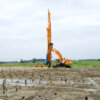Ground improvement techniques are used when the behaviour of the fill mass and/or the underlying soil does not meet required design criteria.
Ground improvement of hydraulic fill can include:
- treatment of the fill mass itself,
- treatment of the subsoil underlying the fill, or
- treatment of both.
Reasons for ground improvement
Ground improvement is carried out to:
- prevent excessive settlements of the surface of the reclamation area when structures like buildings, roads and other foundations are loaded on it;
- improve shear strength of the fill and subsoil to ensure sufficient bearing capacity of the foundations and/or sufficient stability of the slopes;
- increase the density of the fill mass and/or subsoil to prevent liquefaction; and
- improve soil permeability in order to increase drainage capacity.
Benefits of ground improvement
The feasibility of a land reclamation project often depends on the availability of a sufficient amount of good quality fill, within a reasonable distance of the site.
If such fill is not accessible, improvement of the existing ground can offer a cost-effective solution to improve non-compliant material.
Sometimes quality control after construction reveals that certain parts of the reclamation area are inadequate. In that case, these poor quality areas can be repaired at a lesser cost than removing and replacing the inferior soil with higher quality material.
Generally speaking, ground improvement is very flexible and feasible as it can be carried out at any location and at any time after construction is completed. This means that improvement can be limited to the locations where it is actually required. Ground improvement can then be used at other locations wherever and whenever required.
There are however some methods of ground improvement that are less attractive under certain circumstances:
- time-consuming methods like the use of vertical drains, when time is crucial;
- methods that can affect the adjacent structures, like dynamic compaction in the vicinity of existing structures like quay walls or pipelines or buildings.
Ground improvement techniques
Various techniques are available for ground improvement, each with advantages and disadvantages. Selection of the appropriate technique is based on the site specific conditions and the project’s needs. Methods can be distinguished in several ways by:
- techniques that can be applied from the ground surface;
- those that are carried out from a certain depth below the ground surface;
- the nature of the material that can be treated such as cohesive or granular materials;
- the behaviour of the ground needing improvement; and
- the use of admixtures.
The specific techniques that can be utilised for ground improvement are:
- preloading or surcharging with sand, either with or without vertical drains;
- various compaction techniques including vibratory methods,
- soil removal and replacement, stone columns, and geotextile encased sand columns; and
- in-situ admixtures like lime, cement and fly ash.
Ground improvement can play a crucial role in ensuring that the soil and subsoil of a project are safe and secure for the ultimate construction purposes of the reclamation site.




















